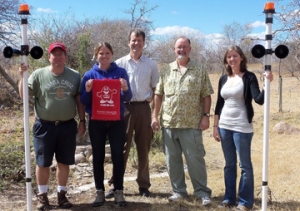Agriculture News
iPod-powered scarecrows could help subsistence farmers protect crops
- Tuesday, February 11th, 2014

WKU researchers are developing “high-tech scarecrows” to reduce crop damage in South Africa. From left in this 2012 photo on the Balule Nature Reserve are Mark Cambron, Department of Engineering; Molly DuVall, graduate student; Bruce Schulte, Department of Biology; Michael Stokes, Department of Biology; Shilo Felton, graduate student.
iPod-powered scarecrows could help subsistence farmers protect crops: When your life depends on the survival of the crops in your garden, as it does for many subsistence farmers across the world, one raid from the animal kingdom can be a serious setback, so solutions for mitigating these human-wildlife conflicts can have end up having a huge positive impact on the livelihoods of the world’s most vulnerable farmers. A group of scientists from WKU, along with collaborators in Africa, are working on a potential solution for keeping wild animals from wreaking havoc on crops and fields by combining the age-old remedy of using a scarecrow to warn off wildlife with a bit of a high-tech component – an iPod.
Thanks to funding from the National Science Foundation and the Bill & Melinda Gates Foundation’s BREAD program, a team of scientists, including wildlife ecologist Michael Stokes and elephant expert Bruce Schulte, from Western Kentucky University (WKU), have been developing a motion activated scarecrow that uses a hacked iPod to control a variety of animal deterrents.
According to Txchnologist, upon being activated by nearby motion, the iPod-powered scarecrows broadcast sounds and stimuli that can deter wildlife, including the roar of lions and animal distress calls accompanied by a flashing strobe light, as well as releasing scents that are alarming to other animals, such as urine from predators.
This “High-tech Scarecrows for Low-tech Farms” project doesn't pretend to aim for complete crop protection from animal foragers, but to instead reduce the amount lost to wildlife, as Stokes states, “If we can reduce crop damage by 10 percent as crops are coming to ripeness, we have been successful.”
"The intention of this research project is not to prevent all HWC, but to determine if changes in animal behavior can be characterized that may reduce specific, common types of crop damage during growing seasons, that in the long term will increase the yield of small shareholder farmers. Reducing HWC by even a few percentage points by disrupting foraging behaviors of animals at the agricultural-wildlife interface could improve food security in areas of Africa where the spectacular wealth of the wildlife resource contrasts with the often desperate poverty of the subsistence farmers." - NSF
The scarecrows aren't intended as a be-all, end-all solution to replace other animal deterrents, but rather to be used when the risk of loss is the greatest, by keeping animals off guard that may have become accustomed to conventional scarecrows. As part of this research project, a digital library of behavioral data, sounds, and schematics for building devices such as the scarecrow or animal training collars will be developed by the Department of Biology at WKU and made available on the web for NGOs or other interested groups.
Some of the links on this page may require additional software to view.

